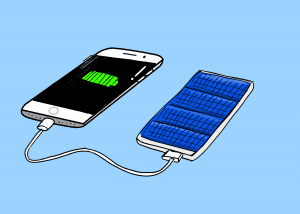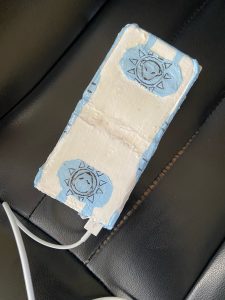A team of STEM School Highlands Ranch Middle School students have created a solar-powered cell phone charger as part of a competition for the Jacobs Teen Innovation Challenge. The Jacobs Institute for Innovation in Education at the University of San Diego is calling for Middle and High School students and educators to join an effort to make a local and global impact, by coming up with an invention that meets the 17 United Nations Global Goals and design thinking. Those goals include no more poverty, zero hunger, affordable and clean energy, climate action, good health and well-being, and many more.
The team tasked with this challenge designed a functional and innovative solar-powered cell phone charger to submit to the competition. The team consists of STEM students Mishika Bhatia, Kaley Kingman, and Suhit Mogadati. Their teacher, Simi Basu, spoke about Jacobs Teen Innovation Challenge, and what it all means.
“Jacobs Teen Innovation Challenge is a worldwide challenge directed by Pactful,” Basu said. “Pactful is an online tool used by students to help them develop an innovator’s mindset.”
Basu says once students heard about the annual challenge, they were very excited to take part and wanted in particular to come up with something that addressed a global problem.
“For our theme, we chose climate action because right now especially with everything going on in the world, like Coronavirus, climate change attention is something that is lacking from our world leaders,” Bhatia said.
Bhatia says her team began working on the project in January 2021, which included researching a problem, interviewing people involved, and coming up with a solution. Their solution was to come up with a prototype for a solar-powered cell phone charger.
“We wanted to make it cheap, trendy, and cool so that it would normalize eco-friendly gadgets and be targeted toward the younger and newer generations,” Bhatia pointed out. “So we did spend a few weeks testing, building, diagramming, and designing the prototype, and we were eventually able to make it faster than a normal phone charger.”
Now the students are working on the pitch phase of the project, and are coming up with marketing ideas for the gadget.
Kingman pointed out that while solar-powered phone chargers already exist, they still aren’t widely known or used by most cell phone users. The team’s goal was to not only come up with a functional gadget but also apply a marketing effort that would make the public actually want to use the new charger instead of the traditional wall charger.
“Marketing is such a critical part of product design,” Kingman said. “If you change the marketing of a product and innovate it in that way, it can go a lot further.”
“We’re going to market this to the average user,” Mogadati said. “Normal solar chargers are directed to hikers and people outdoors, but since this is sleek and trendy, we have to target this to the average audience.”
May 1st is the pitch deadline for Jacobs Teen Innovation Challenge The winners will be announced on Wednesday, May 19. The first-place team will be able to designate a charity to receive $1000 in the team’s name, while second place will receive $750, third place $500, and fourth and fifth place teams will get $250. For more information about the challenge, visit: pactful.org/jtic/
And to see the full interview with the STEM team for the challenge, watch the video below.





